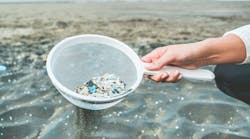Microplastics Are in the News, and Manufacturers Are Seeing Lawsuits
The large-scale production and widespread use of plastics in manufacturing exploded in the 1950s. Since then, a staggering 8.3 billion metric tons of virgin plastics have been produced. Once considered a useful product, about 70% of this plastic is now waste.
When larger plastic items break down, either through wear of products or breakdown in a landfill, “microplastics” are formed. Microplastics can also be directly released into the environment by manufacturing processes. They can enter the environment at every state of their lifecycle, from airborne discharge during manufacturing, shedding during product use, mismanagement of waste and stormwater/wastewater discharges.
Scientific studies have established that we all are exposed to microplastics in the air we breathe, the food we eat, and the water we drink. But the extent of harm to human health and the environment is still being determined. While the scientific community is working to evaluate those effects, the state of California is already leading the way in developing regulations that may impact producers and users of plastics.
Microplastics Regulations on the Horizon
In 2020, the California State Water Resources Control Board became the first regulatory body to define microplastics in drinking water. Its definition is based on particle size and sets the bounds of the size of microplastics to between 1 nanometer and 5,000 micrometers.
The next step in California’s path to understanding microplastics is the development of a comprehensive way to analyze microplastics at a laboratory. There are numerous polymers, additives, colors, sizes, and shapes that make up the universe of microplastics. Collecting these samples, preparing them and analyzing them at a lab is both complex and unlikely to ever have a one-size-fits-all approach. However, once these testing methods are developed, adopted, and accredited in mid-2022, the sampling for (and likely detection of) microplastics will begin. As we have seen with other emerging contaminants, once microplastics can be reliably detected in water, air and soil, liability will likely follow.
Plastics Litigation on the Rise
Plaintiffs, however, are not waiting for the development of microplastics regulations, and instead are suing plastics producers and users under existing legal theories. These cases (filed under federal environmental law, state consumer protection laws, as well as the common law) are having real impacts on industries that produce and use plastics.
Many federal environmental statutes have citizen-suit provisions that allow people and organizations to file lawsuits against alleged polluters. These citizen-suit provisions do not allow plaintiffs to recover damages, but they allow for monetary penalties, injunctive relief, and recovery of plaintiffs’ attorneys’ fees. In recent years, environmental organizations have been using these citizen-suit provisions to target plastic producers.
The Citizen Suit Against Formosa Plastics
In one recent case, San Antonio Bay Estuarine Waterkeeper v. Formosa Plastics Corp., the plaintiff alleged that defendant Formosa Corp., a global manufacturer of resins and petrochemicals, was violating its U.S. Clean Water Act, (CWA) discharge permit by discharging plastic pellets and PVC powder into a surface water body. The permit prohibited the “discharge of floating solids or visible foam in other than trace amounts.” The plaintiff surveyed Formosa’s activities and presented the court with photographic, video, and water sample evidence to demonstrate that Formosa was in violation.
Formosa countered by arguing, in part, that the permit provision did not specify a weight or concentration for the referenced discharge, so it was not in violation. The court disagreed, finding that Formosa discharged plastics on 736 different days in violation of its permit, calling Formosa a “serial offender.” The court also held that Formosa failed to report its noncompliance, as it was required to do under the permit.
After the court issued its decision, the parties entered into a consent decree to memorialize a settlement of the case. As part of the consent decree, Formosa was required to pay $50 million to fund environmental projects to offset the harm it caused to the environment, as well as over $3 million in plaintiffs’ legal fees. Formosa also committed to a number of facility upgrades and monitoring requirements, as well as a zero-plastics discharge commitment by 2024.
Another Legal Avenue
Plaintiffs have also used the federal Resource Conservation and Recovery Act, which regulates solid and hazardous waste, as a mechanism to sue plastics producers. In Charleston Riverkeeper et al. v. Frontier Logistics, plaintiffs sued Frontier Logistics, a plastics transporter, alleging that Frontier discharged plastic pellets that remained in and around a number of surface water bodies. The plaintiffs alleged that Frontier violated the Clean Water Act—and also argued that, by discharging this solid waste, Frontier created an “imminent and substantial endangerment” to human health and the environment, a cause of action provided under RCRA.
Frontier settled the case long before trial, agreeing to pay $1 million to fund environmental projects to clean up the waterways. Frontier also paid $225,000 to cover plaintiffs’ legal fees. In addition, Frontier agreed to an independent audit of its facility and to implement the auditor’s recommendations with regard to environmental safeguards.
Shareholder Suits
Manufacturers have also been subject to shareholder derivative suits for plastics-related claims. In the fall of 2021, a shareholder of Danimer Scientific, Inc. filed a derivative suit alleging that the company’s overstated sustainability claims led to millions of dollars in market capitalization losses. (Perri v. Croskrey, et al.)
Danimer manufactures polymers, resins, and plastic alternatives that are used in a number of plastic products. The company claimed that its products were biodegradable and that they could reduce plastic use and pollution. For one product in particular, “Nodax,” Danimer claimed that it was fully degradable within 12 to 18 weeks after being discarded. According to a Danimer press release, Nodax is a “100% biodegradable, renewable, and sustainable plastic . . . certified as marine-degradable, the highest standard of biodegradability, which verifies the material will fully degrade in ocean water without leaving behind harmful microplastics.” The company made similar representations about Nodax in an SEC Form S-1 registration statement.
Shortly after these statements went public, the Wall Street Journal published a detailed article refuting Danimer’s biodegradation claims. The article cited experts that were skeptical of whether Danimer’s products could really degrade as quickly as advertised under real-world conditions. The article noted that things like ocean temperature, microorganism variation and plastic shape and size will all impact biodegradability and may result in significantly longer timelines for degradation. The next trading day, Danimer’s stock price dropped by almost 13%, and as of this writing the stock was below $10 a share, down from $50 a share in May.
The plaintiff, a Danimer stockholder, filed the derivative suit against the company’s CEO and Chairman of the Board, CFO, and a number of the company’s directors. The plaintiff claims that these officers and directors breached their fiduciary duties to the company by intentionally or recklessly allowing these misstatements to occur, which resulted in significant losses. The plaintiff also sued the officers and directors for unjust enrichment, waste of corporate assets, and breaches of the Exchange Act.
Environmental Litigation
Lastly, plastics users are being targeted in court for their alleged contribution to world-wide plastics pollution. Earth Island Institute, a non-profit environmental group based in Berkeley, Calif., is suing companies including Coca-Cola, Crystal Geyser Water, Clorox, Colgate-Palmolive and others, alleging violations of consumer protection laws they produce and use plastic products that contaminate the environment, and that these products are not as recyclable as the companies claim. (Earth Island Institute v. Crystal Geyser Water Co., et al.) The lawsuit alleges common law theories of liability such as negligence, nuisance, breach of warranty, as well as violations of consumer protection laws, and calls for these companies to stop polluting. In addition, the plaintiff also seeks recovery of resources it is required to expend to combat plastics pollution.
What Can You Do?
We are at the beginning of what will likely be a long road to microplastics regulation. But, as scientific knowledge and sampling efforts develop, regulatory bodies will be looking for ways to stop microplastics from being released into the environment, as well as to clean up those that are already there. And so will plaintiffs.
As we have seen with other emerging contaminants, such as PFAS, these efforts often involve not just the direct product producer, but also many companies that may have used the regulated product (and also many that never used it at all).
Given the ubiquitous nature of microplastics in the environment, regulatory agencies and plaintiffs alike may cast a wide net when identifying potentially responsible parties. But even before we have robust microplastics regulations, plaintiffs are already using existing laws to find ways to target plastics in the environment, from citizen suits to challenging claims regarding sustainability and recycling as they relate to plastics.
So what can plastics producers and users do now? Manufacturers may want to survey their operations and supply chains to determine how plastics are being used—and potentially released into the environment. Manufacturers may also want to evaluate their permits, licenses, approvals, and regulations that apply to their operations to determine if there are ways that an administrative agency, or a plaintiff, may use those mechanisms to address plastics releases.
And smart manufacturers will also want to keep an eye on what happens in California as it moves through the regulatory process for microplastics, as its efforts are likely to be a model for other jurisdictions. These regulations have the potential to directly or indirectly impact plastics producers and users as agencies and plaintiffs look for ways to address microplastics pollution and curtail future releases of the contaminant.
Megan Baroni, Esq., is a partner at Robinson+Cole specializing in environmental, health and safety issues. She frequently represents manufacturers and distributors and contributes to the firm’s Manufacturing Law Blog. Rachel Henke is a project manager at environmental consulting and management firm Roux.The authors would like to thank Catie Boston, a board-certified toxicologist and risk assessor at Roux, for her contributions to this article.





